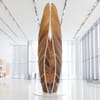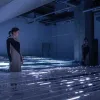The Google Creative Lab is a small team operating without a specific focus area within the cooperation. Comprised of diverse creatives with varied skill sets, they bridge the gap between users and the products generated by Google’s researchers and engineers. Their ultimate goal is to reach as many different people as possible. The process is far from straightforward due to the absence of established briefs, guard lines, timelines, or protocols. Or, to say it in the words of designer Riley Yankowich during their presentation at the design festival OFFF in Barcelona : “When you live in a world of make-believe, you can’t rely on the power of tech and science alone. You have to rely on a world of fiction, emotion, and surprise, a suspension of reality to imagine the future.”
How do you approach cross-functional collaboration and hybrid thinking within Google Creative Lab?
Nicola ‘Gasta’ Gastaldi – Motion Designer, Google Creative Lab: The Creative Lab is built upon this concept. We are all makers with different “superpowers,” and the Lab has no internal departments. We all sit next to each other and nurture the cross-pollination of ideas. So a motion designer sits next to a writer, behind a creative technologist, and in front of the executive creative director. We believe in happy accidents and not confining ourselves by job titles or labels.
JR Schmidt – Motion Designer, Google Creative Lab: Our greatest strength is never waiting for instructions, so we’re constantly making, making, making… Cross-functionally can be disruptive, but many people manage the air-traffic control between our rapid prototyping and the real engineering teams that build the products. Of course, there are also people in the Lab who can approach problems from a more holistic product-centric perspective, so those people are usually best suited to working cross-functionally.
Riley Yankowich – Designer, Google Creative Lab: When everyone runs simultaneously, it’s collaborative chaos. The creative team makes posters or animations, writers work on narratives or storytelling, and technologists build prototypes. It’s all a work in progress at the same time, and it’s a lot of fun to see how it will come together.
It’s also a great way to build on each other. If you’re stuck, you can just ask the person next to you for help. And if you have a great idea, you can share it with everyone and see if they can build on it. It allows creativity to lead the direction of the project.
What challenges did you face when working with emerging technologies?
Nicola ‘Gasta’ Gastaldi (Google Creative Lab): Since joining the Creative Lab 5 years ago, I’ve been lucky enough to work on new technologies, from self-driving cars to synthesizers powered by machine learning tools to full-fledged AI applications. The biggest challenge is making these technologies relevant and using them not just for their own sake or because we work in a tech company but in a way that leverages them to help or inspire people. Our work to support teachers during the pandemic or small business owners navigating digital transformation are examples of using our early access to new tools to ensure they work well for and can be found by the people who need them the most.
JR Schmidt (Google Creative Lab): I think jumping to the end is particularly important here, not just in terms of creative workflow but in terms of future vision. Not every emerging technology will be transformative or even beneficial to society. Jumping to the end, imagining the not-too-distant future where that technology has gained steam, and visualizing helps us navigate and prioritize. That kind of worldbuilding shouldn’t always be strictly optimistic – we need to imagine the pitfalls associated with new technologies as well. When we’re painting this picture, we ask ourselves if that’s a future we’d like to work towards.
What were your biggest learnings when it comes to evolving as a creative?
JR Schmidt (Google Creative Lab): The tools are changing so rapidly, it can be overwhelming. If I was starting as a designer or technologist I’m not sure where I would begin. I always encourage people not to be dependent on a specific tool or piece of software. Experiment with new tools, and be comfortable with learning new skill sets. Motion Design is more than After Effects and Cinema 4D, and some really incredible work can be done when we set those tools aside for a moment.
Riley Yankowich (Google Creative Lab): I think curiosity is essential. With a child-like curiosity, we can explore new ideas and experiment. This can take many forms, such as learning a new tool or talking to people who aren’t tech or creative-focused. Hearing people’s stories and building something backward from them can help us to understand the world around us in a new way. Connecting with people outside of Google is something we do every day, and I believe that using that in our creative work will help us to continue to grow as creatives.
What is the role of a motion designer at Google in bridging the gap between art and science?
Nicola ‘Gasta’ Gastaldi (Google Creative Lab): As a motion designer working at Google, I see the intersection between art and science every day. I use my artistic skills to create motion graphics that communicate complex scientific concepts in a way that is both visually appealing and easy to understand. Know the user, know the magic, connect the two. One of the most important things I have learned is that art and science are not two separate entities. They are two sides of the same coin. Art is about creativity and expression, while science is about logic and reason. But both art and science are about finding patterns and making sense of the world around us.
What advice would you give young creatives just starting out in the industry?
JR Schmidt (Google Creative Lab): Don’t worry about finding a “style.” Your job as a creative is to adapt to the task at hand. And even if you do manage to pin down a visual style and own it… you’ll probably get sick of it, or the visual trends of the day will pass you by. Don’t get too comfortable with your skill sets. Don’t be afraid to pick up a new tool. You’re not just a Creative when you sit at your desk. Don’t forget to be creative in cooking breakfast, folding laundry, making small talk, and lounging around.
Riley Yankowich (Google Creative Lab): Don’t wait for perfection or permission to start creating. Just start making. You can always ask for forgiveness later. It’s much easier to know what works and what doesn’t after you’ve taken action. It doesn’t have to be perfect; just get it down on paper.
What skills and characteristics do creatives need to stay relevant in a rapidly changing industry?
JR Schmidt (Google Creative Lab): I wouldn’t overthink this one. You want to avoid spending your days chasing other people’s ideas. If you’re participating in this world, then you’re relevant. Gluing yourself to someone else’s social feed isn’t necessarily going to lead you to new places creatively.
Nicola ‘Gasta’ Gastaldi (Google Creative Lab): Right now, staying human, nurturing empathy, and connecting with what the world needs the most could be the best soft skill ever. As motion designers, we constantly learn new tools and new render engines, but the art of storytelling is as old as human history. That will never change.





